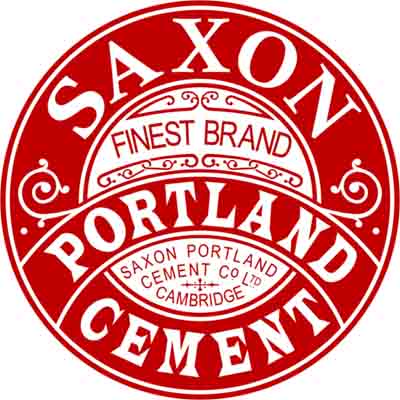
| Pre-1911 Saxon Brand. The logo is identical in design to the "Dragon" brand of the Lawrence Cement Company of Pennsylvania. It would be interesting to know who copied whom. The US company was formed in 1889. |
Location:
- Grid reference: TL4766857811
- x=547668
- y=257811
- 52°11'56"N; 0°9'39"E
- Civil Parish: Cherry Hinton, Cambridgeshire
Clinker manufacture operational: 1901-1913, 1919-1927
Approximate total clinker production: 620,0000 tonnes
Raw materials: Chalk Marl (West Melbury Marly Chalk Formation: 97-100 Ma) from quarry at 547700,257600
Ownership:
- 1900-1911 Saxon Portland Cement Co. Ltd
- 1911-1928 BPCM (Blue Circle)
This plant and the subsequent Norman, only 600 m away, represented an aggressive entry into the industry, financed by the Keeble brothers and with A. C. Davis as the “brains”. They were designed – and proclaimed – from the outset to be supervised by chemists and engineers, to an extent not previously characteristic of the industry. The Atlas Stone Works was set up on the adjacent site, making mainly compressed granite/cement slabs, and operated as a separate company under the management of F. W. Davis, A. C. Davis's brother.
The Saxon plant started up in 1901 at a site adjacent to a previous "coprolite" working, with eight Schneider kilns (centred at 547681,257814). The system was largely sourced from F. L. Smidth. It represented the best dry process technology of the time. Crushed marl was fed to a Smidth dryer, then ground with successive edge-runners and Griffin mills to 0% >212 µm. After blending and correcting, the raw meal was damped and pressed into bricks of house-brick dimensions. The kilns, with one 45 m stack for each set of four, were operated on natural draught. The output was as indicated by Davis much later : initial output (from eight kilns) on natural draught was 560 t/week, and the introduction of forced draught in 1904-1906 raised this to 1200 t/week. However, registered output was 1000 t/week in 1907, 1913 and 1924: because of the proximity of the cheaper-to-run Norman plant, Saxon was used as make-up capacity and rarely ran flat out, and was in any case limited to 1000 t/week by its license. Davis’ capacity of 2000 t/week for 1907 may involve imported clinker. The plant was described in detail in the BPCM 1924 schedule. Heat consumption was initially 8.4 MJ/kg, later reduced to 7.6 MJ/kg. The plant was formally closed in 1928, but it ran at less than 40% capacity from 1923, and last made clinker early in 1927. From 1912 until the mid-1930s, when Norman finally got good finish milling, the plant ground part of Norman's clinker output. The plant used rail for most of its transportation needs. The site was cleared, and is now occupied by the Cambridge University Officer Training Corps. The marl pit is flooded.
Power supply
The entire plant was direct-driven by a 500 HP double-expansion steam engine.
Rawmills
Preliminary crushing of the dried marl was by edge-runner, then three Tiger mills each in closed circuit with an Askham separator. These were followed by a Griffin mill.
No rotary kilns were installed.
Sources:
- Primary Sources:
- Greenhithe Archive
- The Engineer, 105, March 20, 1908, pp 294-296, 298
- BPCM 1924 schedule
- Ordnance Survey 1:2500 mapping
- BGS mapping and monographs
- Confirmatory Sources:
Read the Engineer article.